By Matthew Wandell
One of the most enjoyable parts of working at a public aquarium is the opportunity to care for a wide range of tropical marine fish and see what makes them tick. We all know that some species of fish are harder to keep for a long time in an aquarium than others, but why? For many species we simply cannot provide a suitable approximation of their wild diet. For instance, some of the obligate coral eating butterflyfishes only eat the live coral polyps of certain genera of corals. Save an exceedingly rare individual that adapts to other foods and can gain the proper nutrition from it, these fishes will likely remain extremely difficult to keep for a very long time.
For other species, we can somewhat easily provide a proper diet for them, but the stresses of capture and handling condemn them to an early demise. Ghost pipefish are perhaps a perfect example of a fish of this type; we can easily replicate a diet of small live crustaceans in captivity, but for whatever reason, the vast majority of these fish captured for the aquarium trade die in transit or shortly afterwards. On the other end of this scale would be something like most damselfish species, which hardly seem affected at all by capture and a trip across the world, and are ready to defend themselves and feed right out of the bag. Somewhere in the grey area between these two extremes are the vast majority of marine fish species; some may be considered difficult by aquarists because they often succumb to the types of stresses that handling and transport place on them. My opinion is that many of these species are far less difficult than we give them credit for if they are properly conditioned and handled, not just by collectors and retailers but also by us, the aquarists, as well. In my opinion, the following steps are critical in acclimating delicate fish into captivity.
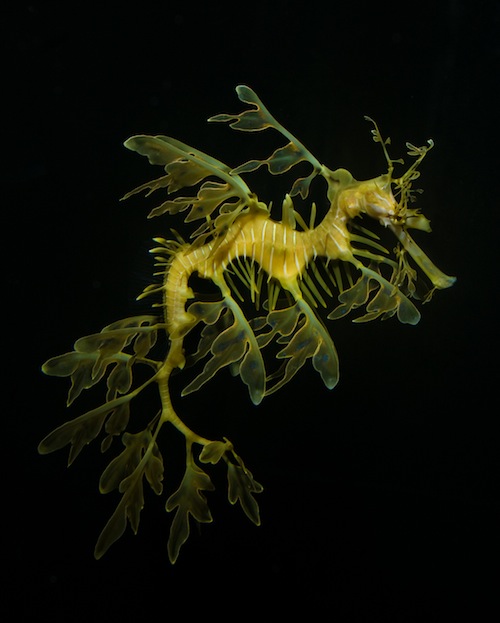
Leafy Seadragons (Phycodurus eques) are extremely delicate and
require a quarantine system where their health and feeding can be
closely monitored. Photo: Rich Ross
Selection and Acclimation
Sometimes a fish will die under our care after just a few days or weeks despite all the best efforts to house it in pristine conditions, acclimate it carefully, quarantine it properly, eradicate any diseases, and feed it more often than we feed ourselves. It’s a fact of the aquarium industry that a certain proportion of fishes will die early due to the stresses of capture and transport, whether they end up in the hands of a rookie aquarist, the world’s greatest fish keeper, or even if you could somehow flop them back into the ocean right where they were previously thriving. Some of this depends on the particular species’ ability to handle the process, and some of it depends on how the people who catch and handle the fish treat it. Was it left in a small bag on a boat in the tropical sun for a day? Was it caught with any kind of chemical? If it’s a fish from deep water, was it adequately decompressed? As much as I’d like to go out and catch and transport every fish I take care of myself, treating it like a baby the whole way home, the economics of the situation currently prevent this. Anybody who has seen me in person can tell you I’d probably make for a pretty awkward fish catcher in any event.
Although we can’t control the treatment of the fish before they get to us, we can choose which fish we buy, where we buy them, and how they are handled after that. While selecting fish, you should pay close attention to their bodies and behavior for any signs of disease or trauma. The belly of the fish should not be pinched in–a fish this starved indicates that it has not had regular access to food in quite a while. Look at both sides of the body and pay close attention to the scales and all the fins–are they red? Do you see any small irregularly colored spots? How about the way the fish swims–does it appear to struggle to maintain its buoyancy or bob at the surface? Is the fish panicking or “pouting” in the corner when you get near the tank? Eating is a good sign, but should not be taken as the sole indicator that a fish is doing “great”–many marine fish will eat like pigs even while they are covered in parasites.
Sometimes even perfectly normal looking fish will drop dead overnight without showing any signs of trauma or disease whatsoever. For this reason, many people suggest having your fish dealer hold the fish for a week or two before picking it up to ensure the fish is doing well. This may be good advice, but it depends a lot on the quality of care the fish is receiving in those one to two weeks. Is it going to be in worse shape two weeks later than it would have been if you had taken it home right away? How do the fish dealer’s tanks and facilities look? Is the store clean, with knowledgeable employees? Is the dealer willing to share information about what country the fish originated from, how long they’ve had it, and are they willing to feed it for you? If not, it may be wise to select another fish dealer altogether. As tempting as it may be to “rescue” diseased or unhappy fish from less than reputable dealers, it only provides economic incentive for that dealer to purchase another fish to replace it and leaves you with an unnecessary burden to try and wean back to health.
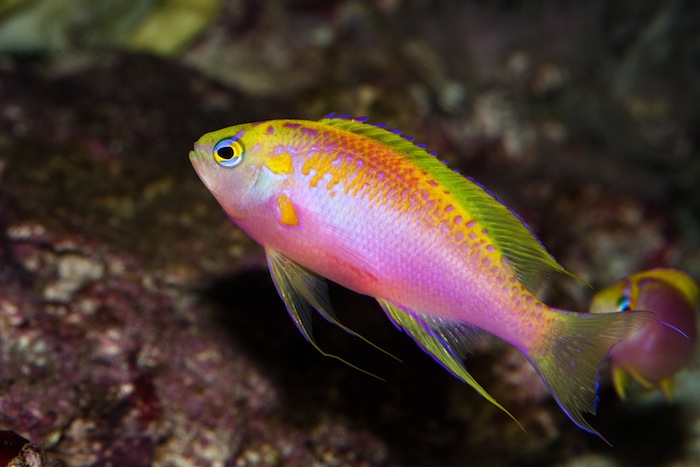
Delicate fish like the Ventralis Anthias (Pseudanthias ventralis) may be more likely to successfully adapt to a bustling community aquarium if they are first allowed to recover from shipping stress in a dedicated quarantine tank.
Photo: J.C. Delbeek
Some online retailers offer “what you see is what you get” fish for sale, where you can view the exact animal you are purchasing, rather than a representative photo, and this can be another good source for healthy fish. At least one online retailer offers pre-quarantined fish that are already eating prepared foods when you receive them. Although the prices for these fishes may be slightly higher, it can be well worth the investment to receive fish that have already made it over this first difficult hurdle in their acclimation to aquarium life. Another option for acquiring fish is to buy them from fellow hobbyists who have had them for a while and for whatever reason do not want them anymore. This may be the best option, as it ensures healthy fish typically free of disease that are usually eating well and already fully acclimated. In many cases, people often charge less for these “used” fish, even though they seem much more valuable than “new” fish.
Regardless of where you acquire your new fish, the first step in placing it into its quarantine tank is to acclimate it to the water conditions slowly. I float the fish bag in the quarantine tank for 10-15 minutes to equalize the temperatures, and then cut the bag open. At this point I take a quick water sample and measure the salinity with a refractometer or conductivity meter. Many fish retailers and wholesalers keep the salinity of their fish holding systems slightly depressed compared to our aquarium systems. If the salinity in the bag is different from that of the tank, I lower the salinity of the quarantine tank to match it. Now with the temperature and salinity matched, some people say you can net the fish out and add it directly to the tank without any other acclimation. I think this can work, but just to be on the safe side I drip a steady stream of water from the tank into the bag until it’s nearly overflowing, then dump nearly all of this water out and repeat the process. This whole process shouldn’t take more than about 30-45 minutes. At this point the fish can be added to the tank. I try to avoid netting or handling the fish if possible and prefer to pour most of the water down the drain until there is just a bit of water and the fish remaining. Then I fill the bag with tank water, submerge it in the tank, and allow the fish to scoot out on its own. A tiny fraction of bag water gets into the quarantine tank, but this is really not that big a deal if you’ve already diluted it sufficiently.
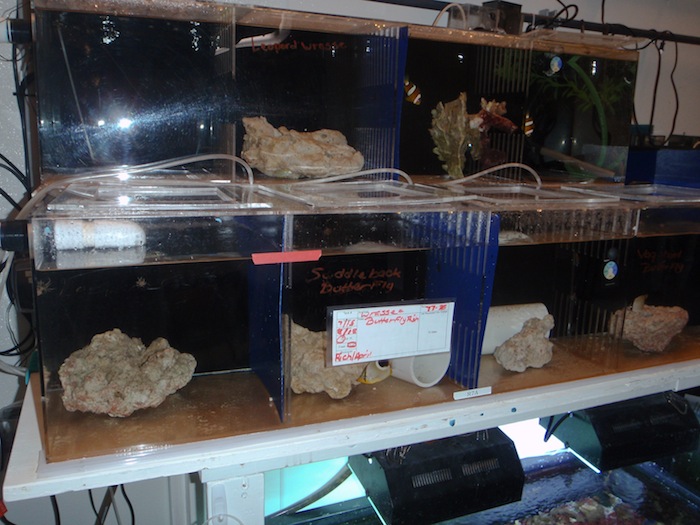
Several fish can be quarantined simultaneously but may need to be kept physically separated if they tend to fight.
Quarantine
Setting up a quarantine tank may be an afterthought for some, but it is absolutely imperative for protecting large fish collections and acclimating delicate fish. Virtually all public aquariums quarantine all of their fish for good reason, and it is not difficult to repeat the same processes at home. You may be surprised to learn that public aquariums generally use relatively simple and cheap systems to quarantine their fish, which makes sense. If it’s not viewable by the public the tank doesn’t need to look very pretty. The most important concerns are simply 1) keeping the water of the proper quality for marine fish, which is relatively straightforward and uses basic materials, 2) reducing stress as much as possible, which doesn’t require any money at all, and 3) feeding the fish well and often, which is money already spent.
A note about the difference between a quarantine tank and a treatment tank–a quarantine tank is simply a system where an animal and the water housing it are isolated from all other animals for a period decided by the aquarist. A treatment tank is a quarantine tank with the addition of medications or other treatments in order to target a particular disease or condition. I prefer to not treat my fish with medication proactively due to the deleterious effects on appetite and the immune system that many medications can cause, but this is strictly my opinion and is likely not shared by all. There is no “panacea” treatment that will kill all fish parasites, and some treatments may provide more suitable conditions for other parasites. A medication to kill Cryptocaryon will have no effect on monogenean flukes, for instance, and a hyposalinity treatment to kill Cryptocaryon may aid the growth of the protozoan Uronema. Thus the most important step in affecting a proper treatment is to properly diagnose the disease, and this cannot always be done with a visual inspection. Skin scrapes and gill clippings can be useful tools in diagnosing the cause of (but not necessarily ruling out the presence of) a large variety of parasites that afflict marine fish. For those advanced fish keepers interested in doing their own fish diagnosis and treatment at home I would strongly recommend investing about $300 into a copy of “Fish Disease: Diagnosis and Treatment” by Dr. Edward J. Noga and a small high quality microscope kit. I am fortunate enough to work at a public aquarium where we can quickly and accurately diagnose and treat most fish diseases, but in the absence of these tools it may be beneficial to treat your fish under the assumption that they are carrying certain particularly common parasites.
The unfortunate reality is that many hobbyists do not consider setting up a quarantine tank a necessary component of their reef aquarium due possibly to space, time, or cost restrictions. Some feel that putting a fish in quarantine is more stressful for the fish than adding it directly to a fully established reef aquarium. In my opinion, fish will be far more likely to acclimate successfully to captivity and live longer, healthier lives if first placed into a proper quarantine tank rather than directly into an established system. Key word: “Proper”–there are as many flavors of quarantine tanks as there are reef systems, and some are more successful than others. I hope here to clear up some possible misconceptions concerning quarantine and address some common problems and the solutions that have worked for me.
Misconception #1: Quarantine tanks need to be elaborate
I find the easiest way to keep a quarantine tank is with a few large chunks of live rock, a couple airstones attached to an air pump, a heater, and twice weekly 25-50% water changes. That’s about it! I like to do relatively frequent and large water changes because I like to feed frequently and heavily, especially with new fish, and removing any uneaten food is a necessary chore. The peace of mind is worth the $20 or so it will cost in salt. Just about any brand of salt will do for water changes as long as the water has been mixing for a day or two at the proper temperature and salinity. Many people keep their quarantine tank continuously running much like a small reef tank minus corals, and develop lush growths of macroalgae and a large population of small invertebrates to graze on which offers ideal feeding opportunities for finicky fish. If you have a protein skimmer, activated carbon filter, UV sterilizer or any other filter laying around, by all means use them, but I find these things to be unnecessary complications on quarantine tanks except in certain special cases.
Misconception #2: Delicate fish should skip quarantine because it’s stressful
I’ve been fortunate enough to care for some of the most delicate marine animals one can acquire–Purple Queen Anthias (Pseudanthias tuka), Orange Spotted Filefish (Oxymonacanthus longirostris), Copperbanded Butterflyfish (Chelmon rostratus), Mandarinfishes (Synchiropus spp.), Leopard Wrasses (Macropharyngyodon spp.), Tilefish (Hoplolatilus spp.), Garden Eels (Heteroconger spp.), Seahorses, Pipefishes, and Seadragons (Syngnathidae family)–and all of them spent at least 30 days in quarantine tanks before being placed into a display tank, some even longer. In all cases, I’d say these fish acclimated to captivity so well because of their time spent in quarantine, not despite it. Most of these fish, despite their delicate reputations, are relatively straightforward to keep after they are eating well on a variety of prepared foods; they settle into the routines of a controlled environment after 3-6 months. Those first few months are the tricky part. It is no easy task to get some of these fish eating, and to compound that problem, nearly all of them suffer greatly from the stresses of handling and transport. We are doing the fish a favor by letting it rest and recover without aggressive resident fishes picking on it while it tries to find a hiding spot or feed in its new home. Quarantine also offers us the opportunity to more easily observe the feeding behavior of the fish, target feed it with small live foods that would quickly disappear in a crowded reef tank, and gradually convert it over to prepared foods.
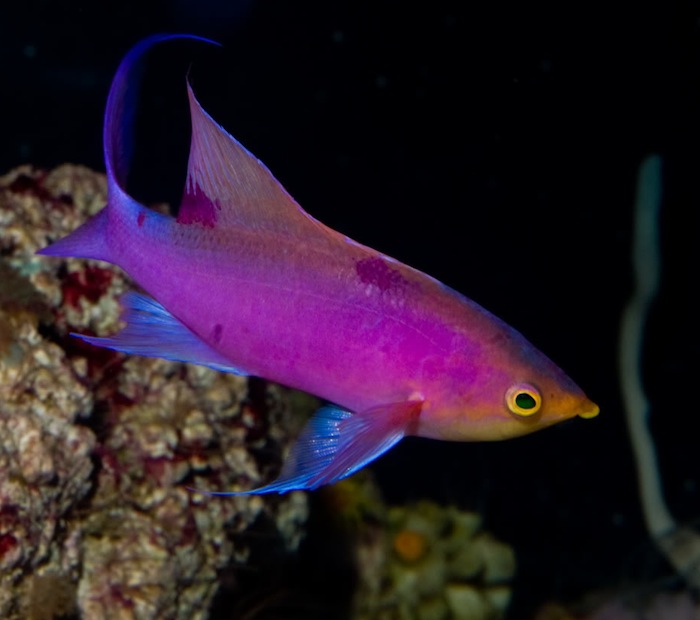
This Purple Queen Anthias (Pseudanthias tuka) thrived and changed from a small female to a supermale while kept in a very simple quarantine tank for 9 months. The tank was filtered solely by live rock and airstones.
Photo: Rich Ross
Misconception #3: Fish are less stressed in an established reef system
So you’ve got your big needlewheel skimmer churning out buckets of foam, the calcium reactor is dialed in, that last patch of cyanobacteria is finally gone, and maybe you’re even doing carbon additions to keep your nitrate and phosphate levels at “zero”. This is all well and good for the corals, of course, but as far as marine fish are concerned, it’s mostly meaningless. Besides the obvious parameters of temperature and salinity, the two most relevant water quality parameters that aquarists should concern themselves with in a quarantine tank are nitrogen compounds (ammonia and nitrite specifically) and dissolved oxygen. Fortunately these can be controlled relatively cheaply and easily. A few large pieces of live rock will provide more than enough bacteria to provide adequate denitrification. I keep previously “dead” live rock in the sump of an established reef system for use in quarantine tanks, and intentionally select pieces that are free of large sponges, corals, or other invertebrates in case a disease treatment is required. Ammonia and nitrite test kits are widely available, and these should both be non-detectable at all times in a quarantine tank. I keep a SeaChem Ammonia Alert badge in all my quarantine tanks to alert me immediately if there is any ammonia present in the water. Dissolved oxygen is a little trickier to measure accurately and cheaply in saltwater, so I play it safe by increasing the gas exchange in the quarantine tank to ensure the oxygen level is as close to saturated as possible. I use one or two airstones turned up fairly high to keep the water really moving in the tank and at the surface. With regular water changes as described above, all other parameters, especially nitrate and phosphate, can safely be ignored. This offers a distinct advantage over placing a fish directly into your established reef system–you can feed it heavily and repeatedly without needing to overly concern yourself with nutrient problems.
Reduce Stress
Perhaps even more important than maintaining good water quality is simply letting the fish be and reducing all forms of external stress in its environment. In practice, this means offering it a secure hiding place, keeping a low to moderate level of light on a regular schedule, and just plain not disturbing the fish or the tank. I like using live rock for a couple reasons–besides being a great biological filter, it provides a “natural” hiding place that fish recognize and quickly learn to retreat to. I like to make a nice cave structure with the live rock that allows the fish to hide its entire body completely from view. I can’t say exactly what a fish is thinking when it sees plastic plants, fake corals, or PVC fittings, but based on some initial reactions, I’d call it confusion. For those species that bury themselves or retreat into a hole near the bottom, I place a sufficiently deep layer of fine sand on the bottom of the entire tank. Similarly, I think placing some sand in a small container while leaving the rest of the tank bare may be expecting a lot out of an animal that isn’t familiar with how a Tupperware works. Although it is tempting to lift up the rocks and make sure everything is “okay” in the tank if we haven’t seen the new fish in a few days, it will only make it less likely to feel comfortable and venture out of its hiding space to feed. Likewise, quick movements or people constantly near the tank may scare it enough to remain in hiding. We may eagerly want to watch our newly acquired fish up close, but I can assure you the fish has different thoughts on the matter. Once the rockwork is arranged and the fish has been added to the tank, I don’t like to place my hands into the aquarium other than to siphon the bottom during a water change. Some skittish species may take several days or weeks to feel comfortable enough to come out of hiding but may quickly retreat when you approach the tank. For skittish species like this, I like to cover the sides of the tank with plastic sheeting, newspaper, or whatever is handy so that the fish can’t see me, leaving a small opening for observation during feedings. Speaking of feeding…
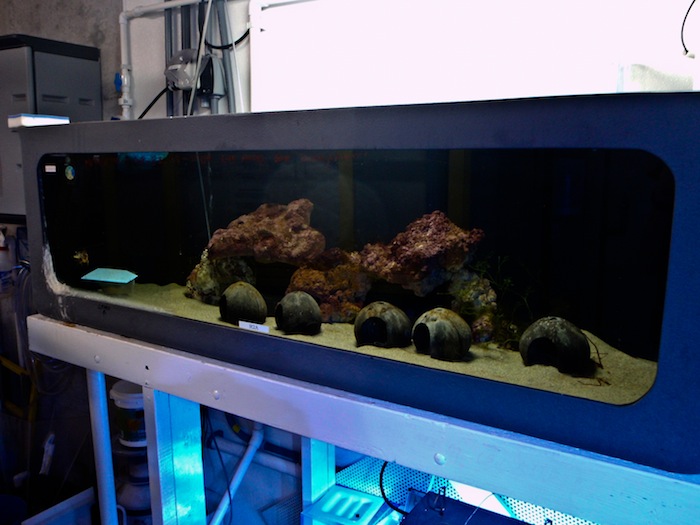
While setups need not be elaborate, they should provide adequate shelter to make specimens feel at ease.
Feed, feed, feed!
Many of the marine fish species with delicate reputations have earned these reputations because of our inability to satisfy their feeding behavior, either in feeding frequency or food type. Almost all newly imported marine fish have gone through a stress-filled journey in the chain of custody from ocean to aquarium in small bags being jostled around from tank to tank only to be netted up again to repeat the process every few days. More often than not, they are sparsely fed during the breaks in this journey if they are willing to feed at all. Imagine how we’d feel after taking a long plane trip around the world without any in-flight meals, and then repeating the journey a few times with only breaks of a few hours or days in between. It’s safe to say most of us would be ready for a nice steak dinner afterwards. Hell, even a few microwaved gas station burritos would work, right? When you’re really hungry, all food looks good, as long as you recognize it as food. All that matters in the short run is getting calories to provide your body with the energy to move yourself around (taxi to the hotel), defend yourself (privacy please), fight off infection (shower and a nap), and seek out more food (call room service). In these respects, marine fish are not much different from us. What they need during the quarantine period and for the first few months afterwards is calories, in whatever form is available, to provide their body with energy to repair their immune system and the damage done to their bodies during handling and transport. There is a lot of great information available about the nutritional value of different marine fish feeds and their impact on the long term health of our fish, and I would implore all dedicated fish keepers to seek out this information and apply it as you see fit. But for the purposes of feeding during quarantine, you can mostly ignore it. If the fish will eat it, I keep feeding it to them, and I feed it often. This includes foods that other experienced fish keepers may chide you for using, such as adult brine shrimp, blackworms, feeder guppies, etc., and at a frequency that many reef keepers would strictly avoid on their reef tank, say 8-10 times per day. Some species may benefit from a bit of live brine shrimp in the water at all times. Please keep in mind the food items and feeding frequency during quarantine are not necessarily intended to become a staple diet, but as a temporary crutch to get them eating and get calories in them quickly.
A bit of research into the wild diet of the species in question is indispensable in determining a strategy to initiate feeding in a controlled environment. For instance, a quick look at Fishbase.org indicates that Copperbanded Butterflyfish eat “benthic invertebrates”, and based on the diet of other butterflyfishes and that peculiar snout we can make an educated guess that they spend a lot of time nibbling at small animals in nooks of live rock and coral heads. One simple trick for getting Copperbandeds to eat is to chop up frozen shrimp into a fine paste and then smear it like glue into the cracks and crevices of a stony coral skeleton like Pocillopora or even into a small head of raw broccoli. Then this is attached to a small rock and sunk to the bottom of the quarantine aquarium, and we walk away from the tank to observe from afar. Sometimes it works, and if it doesn’t we keep trying and move onto other ideas–live blackworms, live mysis shrimp, a cracked open clam, or live brine shrimp, and persist with feeding whatever ends up working. Sometimes it takes longer for a fish to learn to eat prepared foods than the quarantine period lasts, which is fine. If we’ve set up and maintained the quarantine tank well, this is no reason for concern, and we can just keep the fish in the quarantine tank indefinitely. I’ve kept many fish in bare quarantine tanks for several months, including female anthias that changed sex to males and cardinalfish that spawned and held eggs, that were only filtered by some live rock, airstones, and frequent water changes.
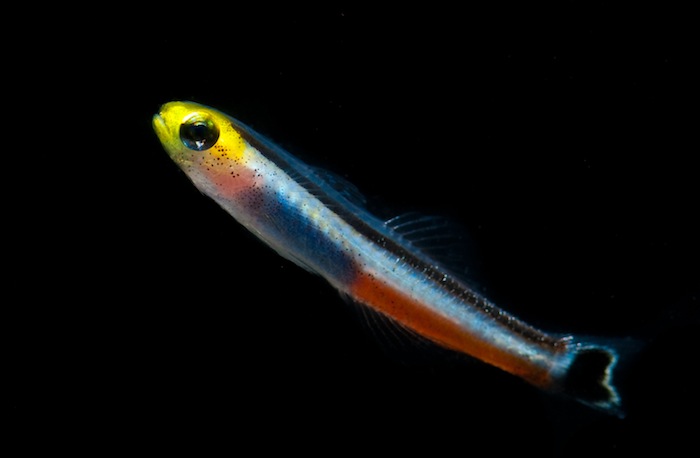
This dwarf Dartfish (Aiolips megastigma) thrived in a quarantine tank with a constant supply of small live foods. Photo: Rich Ross
Introduction
Now that we’ve got a healthy, plump and vibrant fish eating a variety of foods, let’s stick it in the damn tank! A healthy fish will be able to assert itself and compete for food in a community reef tank much more effectively than one that made the journey across the world in a bag the previous week. I like to catch up fish from the quarantine tank in a bucket or plastic bag whenever possible, or barring that, a very soft net that will not damage the scales, fins or eyes of the fish. A slow drip acclimation as discussed previously will aid the fish to adapt to the new tank’s water conditions. I like to feed the resident fish heavily right before and during adding a new fish, mostly to distract them while the new fish finds a new shelter for itself.
I hope that this article has inspired you to try some delicate or advanced species of fish that you hadn’t thought possible before in your aquarium. I can be reached at[email protected] for any further questions or comments.


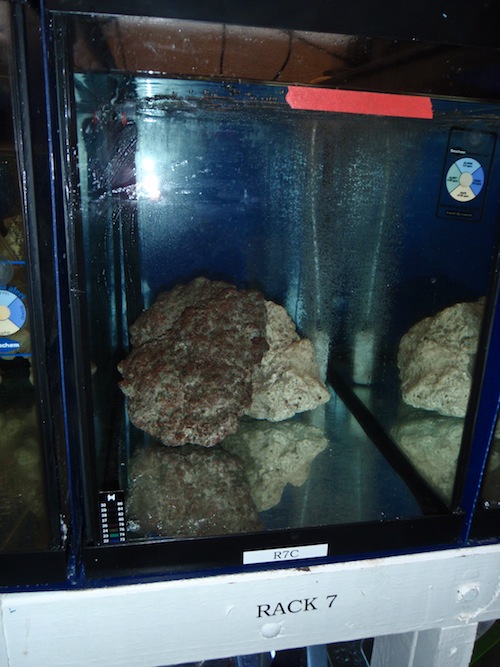

0 Comments